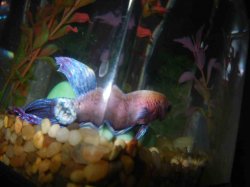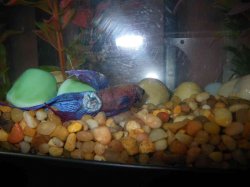Hi, I have a betta that has developed a sore on his side, near to the back fin. It's not bloody, there's nothing protruding, but it looks like a large sore. He has been sick for a while, and up until I saw the sore I thought his fins looked pretty health, and we had our water tested, but I hadn't seen the sore until today. Our water had high levels of ammonia so I used distilled water instead of tap and cleaned out the tank entirely. He's the only betta in a 1.5 gallon tank with a heater and a filter. So, from everything I've read, it sounds like I should get a new quarantine tank, fill with water (distilled?), wait several hours for it to warm up to the appropriate temperature (use my heater - disinfect it?), add antibiotics (the only ones available immediately are Mardel Maracyn) and water conditioners? and move my fish.
Should I get a second tank ready for salt baths or do I add salt to the quarantine tank? I feel terrible that our betta is suffering. We have had to move him a lot lately, and I think it may be stress. Anything to help with the stress of moving him back and forth between tanks? Do I need to throw out my tank and start completely over or will bleach work? You can see a couple of photos of him at: http /www.mediafire.com/?xdze12x1fufd9t5,http
/www.mediafire.com/?xdze12x1fufd9t5,http /www.mediafire.com/?g5c5dmggg86yqv7. He often sits like this at the bottom of the tank (facing up) and then you can see the sore at the base of the body by the tail. Any help or advice would be much appreciated. I can't seem to get any great help at Petsmart (where I got him).
/www.mediafire.com/?g5c5dmggg86yqv7. He often sits like this at the bottom of the tank (facing up) and then you can see the sore at the base of the body by the tail. Any help or advice would be much appreciated. I can't seem to get any great help at Petsmart (where I got him).
Thanks!
Should I get a second tank ready for salt baths or do I add salt to the quarantine tank? I feel terrible that our betta is suffering. We have had to move him a lot lately, and I think it may be stress. Anything to help with the stress of moving him back and forth between tanks? Do I need to throw out my tank and start completely over or will bleach work? You can see a couple of photos of him at: http
 /www.mediafire.com/?xdze12x1fufd9t5,http
/www.mediafire.com/?xdze12x1fufd9t5,http /www.mediafire.com/?g5c5dmggg86yqv7. He often sits like this at the bottom of the tank (facing up) and then you can see the sore at the base of the body by the tail. Any help or advice would be much appreciated. I can't seem to get any great help at Petsmart (where I got him).
/www.mediafire.com/?g5c5dmggg86yqv7. He often sits like this at the bottom of the tank (facing up) and then you can see the sore at the base of the body by the tail. Any help or advice would be much appreciated. I can't seem to get any great help at Petsmart (where I got him).Thanks!




